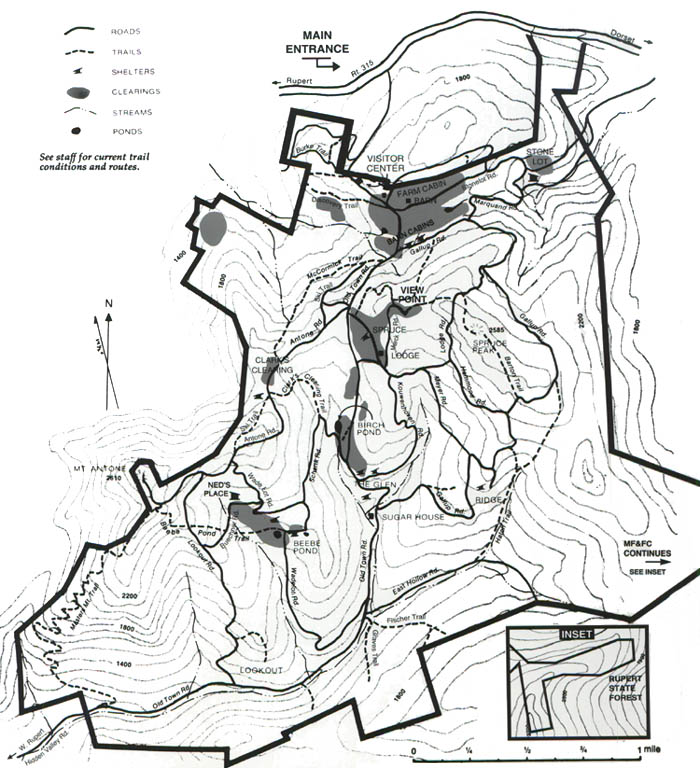Case Study

|
Case Study |
|
Mission Statement: Merck Forest & Farmland Center teaches a land ethic by caring for and managing over 3,100 acres of Vermont field, farm and forest, and by providing educational and recreational experiences to enrich the lives of those who come here, helping them and others to become good stewards of the land.
A Rich History from Simple Beginnings
George Merck, CEO of Merck & Co. pharmaceuticals, founded the Vermont Forest and Farmland Foundation in 1950--what would later become Merck Forest and Farm Center. The farm consisted of land he had purchased 10 years earlier and was inspired by a vision of sustainability. What George observed --a general degradation of land and the overwhelming creation of wood lots--on his new farm in Rupert, VT. was largely due to a lack of education regarding sustainable agriculture. Over the years, he acquired more land with the intention of creating an educational forum for agriculture and forestry. As such, he spearheaded an educational outreach network with the surrounding communities--including workshops with neighboring farmers and monetary incentives for sustainable farming.
Today, Merck Forest and Farmland Center has continued what Merck began roughly half a century ago. It has expanded as well to include the following:
- Alternative Energy: a practical, economic, and ecological decision
For many years, Merck Farm grappled with problem of how to bring electric power to their organization. Given the distance from the road (roughly one mile), hooking into the energy grid would have coasted $40,000. This large expense inspired the farm to explore alternatives. Location and clean consumption pointed arrows towards solar, wind and wood--all of which now generate more than adequate power to the Farm.
Wind Generation at the Farm
Merck Farm's newest addition was a wind turbine in the Spring of 2000. Prior to wind power, the Farm operated from gasoline, propane generators, and solar panels. In addition to these forms of off-the-grid energy, wind power provides a clean, reliable and overall low cost source of energy. Apropos to the conceived drawback of wind--variability, the Farm is perfectly situated for strong and steady wind patterns( they are perched upon hilltop within the Tectonic range, with steep valleys to the west acting as a functional wind tunnel), wind is an extremely reliable source of power. The wind power will also serve as one of many educational tools on the farm. The additional energy input form the wind mill has generated enough power to meet not only their current daily consumption, but will also allow for much needed additional appliances. Furthermore, to mitigate any aesthetic concerns (for the generator's blades are 23 feet wide and it sites 80 feet in the air), the model they purchased makes almost no noise while operating. It also does not pose a threat to birds.
Solar Power at Merck Farm
Active solar power is an additional form of energy for the Farm. Although most energy does come from the wind generator, the visitor center draws a lot of its power from the ...panels which sit on its roof. These panels are functional in two ways: they produce clean energy, thus reducing the need for fossil fuels, and 2) they are education tools; the visitor's center describes the conversion processes of solar radiation to consumable energy via the technology or photovoltaic cells within an active solar system. Additional panels are also used in the straw bale building , which is currently still under construction.
A Neat, alternative, Building Idea: Straw Bale Building
In 1997, Merck Farm decided to build what was destine to be the first publicly permitted straw bale building in Vermont. Before building began, the farm chose a location which maximized the insulative properties of the straw bale construction: the built into the side of a wind-guarded slope, for the temperature below ground remains ~52 degrees year round. The building's post and beam frame came mostly from Merck lumber which is harvested in a sustainable manner (1-2 cords per acre per year). The walls consist of stacked straw bales held together by maple saplings and chicken wire. Stucco covering add the finishing touch.
In many ways this building is a symbolic microcosm of the entire farm--its construction and energy sources (wood, solar, and wind) are entirely ecological. In addition to some small solar panels, the orientation of the building is done in such a manner as to maximize passive solar input: it faces south and has large windows to capture heat. The two panels and the small windmill on the roof provide 420watts for their 12 volt electrical system. The floor also deserves mention; 900 ft of plastic tubing was laid in the concrete when it was poured. The tubing is connected to the wood stove and contains a mixture of antifreeze and water. When the stove is lit, the mixture gets warms and then circulated around the floor.All of the components of this building--photovoltaic and wind energy, radiant heat flooring, southern orientation, and banked earth construction--can be used in home and building construction to lessen general consumption of fossil fuels.
The farm made the decision of straw bale construction for the following reasons:
had a wonderful visit in a spectacular place. You can
check out the farm virtually through their web page at www.merckforest.org.
We have provided a map of the grounds to give you a better idea of how the farm and adjacent forest lands are set up:

Check out the farm virtually through their web page: www.merckforest.org